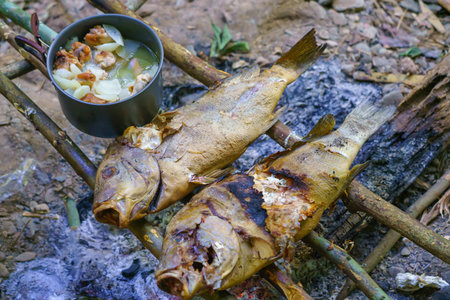Introduction to Bengali Fish Curry – Roots and Significance
When you think of iconic Indian dishes, Macher Jhol immediately stands out as a symbol of Bengali pride and tradition. This legendary fish curry is not just a meal—its an emotion deeply woven into the cultural fabric of West Bengal and Bangladesh. For every Bengali household, Macher Jhol is more than food; it represents warmth, family bonding, and the unique culinary legacy passed down through generations. The dish embodies the essence of Bengal’s love affair with freshwater fish, particularly Rohu (Rui) or Catla, combined with the punchy flavours of mustard oil, turmeric, and seasonal vegetables. Across India, Macher Jhol has gained legendary status for its simplicity, health benefits, and authentic taste that keeps both locals and food enthusiasts coming back for more. Whether it’s during Durga Puja festivities or a lazy Sunday lunch, serving Macher Jhol is almost a ritual in Bengali homes, signifying hospitality and a deep-rooted connection to one’s heritage.
Essential Ingredients – What Makes a Perfect Macher Jhol
When it comes to preparing an authentic Bengali Macher Jhol, the secret lies in using the right ingredients sourced from your local Indian market. The selection of fish, spices, and vegetables plays a decisive role in creating the soul-satisfying taste that is unique to this iconic dish from Bengal.
The Star Ingredient: Freshwater Fish
Bengali cuisine is synonymous with fish, and for Macher Jhol, nothing beats the locally popular varieties. Hilsa (Ilish), Rohu (Rui), Katla, or Bhetki are the go-to choices for an authentic flavour profile. These fishes are prized for their tender flesh and ability to absorb spices beautifully. In India, these varieties are readily available at local markets, ensuring you get that home-style taste every time.
| Fish Type | Bengali Name | Key Characteristics |
|---|---|---|
| Hilsa | Ilish | Rich flavour, oily texture, traditional favourite |
| Rohu | Rui | Mild taste, firm flesh, widely used |
| Katla | Katla | Slightly larger flakes, absorbs gravy well |
| Bhetki | Bhetki | Soft texture, subtle flavour, boneless options available |
The Flavour Arsenal: Spices & Aromatics
No Bengali curry is complete without its signature medley of spices. For Macher Jhol, the essentials include mustard oil (for that pungent kick), turmeric powder (haldi), red chilli powder (lal mirch), cumin seeds (jeera), coriander powder (dhaniya), bay leaves (tej patta), and nigella seeds (kalonji or kalo jeere). Ginger paste and green chillies add depth and heat. Each spice brings its own layer of complexity—don’t skip any if you want the real deal!
| Spice/Aromatic | Local Name in Bengal/India | Role in Dish |
|---|---|---|
| Mustard Oil | Sarson Tel | Main cooking medium; gives pungency & aroma |
| Nigella Seeds | Kalo Jeere/Kalonji | Tempering; adds earthy fragrance and punchy flavour |
| Cumin Seeds/Powder | Jeera/Gura Jeera | Adds warmth and base flavour to curry sauce |
| Coriander Powder | Dhone Gura/Dhaniya Powder | Mild sweetness; rounds off other flavours elegantly |
| Turmeric Powder | Halud/Haldi Powder | Signature golden colour; anti-inflammatory benefits too! |
The Veggie Line-Up: Seasonal and Local Picks Matter
Macher Jhol is as much about fish as it is about the fresh vegetables that simmer along with it. Potatoes (aloo) are non-negotiable and soak up all the tangy-spicy goodness of the gravy. Other local favourites include brinjal (begun), pointed gourd (potol/parwal), and sometimes tomatoes for a bit of tanginess. Picking seasonal vegetables from your local bazaar ensures maximum freshness and flavour.
| Vegetable Name | Bengali Name | Taste Contribution |
|---|---|---|
| Potato | Aloo | Adds body and mild sweetness to curry |
| Brinjal/Eggplant | Begun | Smoothens texture; absorbs gravy |
| Pointed Gourd | Potol/Parwal | Crisp bite; balances richness |
| Tomato | Tamatar | Mild acidity; enhances tanginess |
A Note on Water & Salt: The Unsung Heroes
Bengali curries like Macher Jhol are typically runny (“jhol” literally means broth). Use clean water—preferably filtered—for best results. For salt, use common iodised salt or Himalayan pink salt according to your family’s tradition.
The Winning Combo – Why Authentic Ingredients Matter
If you want your homemade Macher Jhol to taste just like what you’d get in a Bengali household—from Kolkata to Durgapur—sticking to these authentic ingredients is key. Every item listed above contributes to the signature harmony of flavours that makes this curry such a beloved staple across Bengal and beyond.

3. Step-by-Step Preparation Guide
Marinating the Fish: The Foundation of Flavour
Begin by cleaning your choice of freshwater fish—Rohu, Katla, or Hilsa are classic picks for authentic Macher Jhol in Bengal. Cut the fish into medium pieces and pat them dry. In a large bowl, add a generous pinch of haldi (turmeric powder), namak (salt), and just a few drops of fresh lime juice. Gently massage the marinade into each piece, ensuring even coating. For best results, let the fish rest for 15-20 minutes; this step not only infuses flavour but also helps achieve that signature golden crust during frying.
Frying the Fish: The Bengali Technique
Heat mustard oil in a kadai (wok) until it just starts to smoke—a crucial step for that deep, rustic aroma. Slide in the marinated fish pieces one at a time, frying on medium-high heat till both sides turn golden brown. Be careful not to overcrowd the pan; fry in batches if needed for even cooking and crispiness. Remove and set aside on a plate lined with kitchen paper to drain excess oil.
Preparing the Curry Base: Layering Traditional Flavours
In the same oil, toss in kala jeera (nigella seeds) and slit green chillies for that unmistakable Bengali zing. Add finely chopped onions and sauté until they turn translucent, followed by ginger-garlic paste. Mix in more haldi, red chilli powder, and freshly ground dhania (coriander powder). Stir well, allowing the masala to release its oil—a sign that it’s perfectly cooked.
Assembling the Curry: Bringing it All Together
Add ripe tomato puree or chopped tomatoes and cook until soft. Pour water as per desired consistency—Bengali jhol is typically light and runny rather than thick. Once the curry comes to a gentle boil, slide in the fried fish pieces carefully. Simmer on low flame so the fish soaks up all those aromatic spices without breaking apart.
Bengali Home Kitchen Pro-Tips:
- Always use mustard oil for authentic taste; its pungency is irreplaceable.
- A dash of garam masala at the end elevates the flavour profile.
- Add a few fresh coriander leaves for garnish before serving—it’s simple yet essential for visual appeal and freshness.
Follow these steps with attention to detail, and you’ll be rewarded with an aromatic, homestyle Macher Jhol straight from a Bengali kitchen—perfect with steaming rice on any Indian dining table!
4. Serving Suggestions – Traditional Indian Style
When it comes to enjoying Macher Jhol in authentic Bengali fashion, presentation and pairing are just as important as the recipe itself. Bengalis take great pride in their meal rituals, and serving this fish curry correctly elevates the entire dining experience. The most classic way to serve Macher Jhol is with a generous helping of hot steamed rice (bhaat), which soaks up the flavourful gravy and balances the spice. Alternatively, you can pair it with luchi – a soft, deep-fried flatbread beloved across Bengal for festive meals and Sunday lunches.
How to Plate Macher Jhol Like a Local
Bengali households follow a disciplined sequence during meals. Traditionally, the rice is served first, neatly shaped into a mound or square using a katori (small bowl). Next, ladle the piping hot Macher Jhol over the rice or serve it on the side in a small bowl (bati). The fish pieces should remain intact, showing off their golden crust from frying. Garnish with fresh coriander and a wedge of lemon for that extra zing.
Classic Bengali Sides to Pair with Macher Jhol
| Side Dish | Description |
|---|---|
| Steamed Rice (Bhaat) | The undisputed partner for all Bengali curries; absorbs flavours perfectly. |
| Luchi | Fluffy, deep-fried flatbreads, ideal for scooping up curry during special occasions. |
| Aloo Bhaja | Crispy fried potato sticks often served alongside for added crunch. |
| Begun Bhaja | Slices of fried eggplant that complement the tangy notes of the curry. |
Bengali Mealtime Rituals & Pro Tips
Bengalis usually start their lunch with a bitter dish like shukto before moving on to mains like Macher Jhol. To eat authentically, use your right hand – mixing rice and curry together for each bite. Serve some green chillies and raw onion rings on the side for an extra kick. And don’t forget: in many Bengali homes, the head piece of the fish is reserved for elders or special guests as a mark of respect.
Whether you’re hosting friends or reliving memories of Kolkata, following these traditional serving suggestions will ensure your Macher Jhol truly stands out at any Indian table.
5. Tips, Tricks, and Local Twists
Expert Tactics to Elevate Your Macher Jhol
For an authentic Bengali fish curry experience, the devil is in the details. Mastering Macher Jhol means going beyond the basic recipe and understanding the regional nuances that make this dish a true celebration of Bengal. Here are some tried-and-tested expert tactics to take your curry from good to legendary.
Selecting the Freshest Fish – A Bengali Must-Do
In India, a trip to the local fish market (machher bajar) is almost a ritual for Bengalis. For Macher Jhol, opt for Rui (Rohu), Katla, or Hilsa if you’re aiming for classic authenticity. When shopping, ensure the gills are bright red and eyes clear – never settle for frozen fillets! In South Indian states, you might substitute with Seer or Pomfret, but always ask your local machhwala for their freshest catch of the day.
The Oil Matters – Mustard Oil Magic
No shortcut here: traditionalists swear by pungent raw mustard oil for its signature zing. If you can’t handle its intensity, heat it till it smokes lightly before cooking. This neutralizes bitterness while still giving that punchy aroma every Bengali craves.
Spices: Toasted & Freshly Ground
Garam masala varies across Bengal; in Kolkata, a touch of cinnamon and clove is preferred, while rural areas favour panch phoron (the iconic five-spice blend). Toast your spices just before grinding to unleash their full potential — this is a game-changer and what separates home cooks from restaurant-style results.
Local Veggie Additions
Bengali home kitchens often add potatoes cut into long wedges (“aloo bori”), and sometimes pointed gourd (parwal) or eggplant. These absorb the curry’s flavours and add body to the dish. Don’t skip them if you want a taste that feels like a true Kolkata household.
Extra Pro-Tip: Sourcing Ingredients in Indian Markets
Seek out “desi” varieties of vegetables and fish rather than imported ones at supermarkets. Visit early morning haats (markets) for the best selection. When buying mustard oil or whole spices, choose brands trusted by locals—like Fortune or Patanjali—and always check manufacturing dates for freshness.
Finishing Touches: The Bengali Way
Add fresh coriander leaves just before serving; squeeze a dash of gondhoraj lebu (aromatic lime) if available. Serve hot with steaming rice — and remember, as any Bengali would say: “Macher jhol-r swaad kintu haater adaye!” (The taste of fish curry is all about your personal touch!)
6. FAQs and Common Mistakes to Avoid
Frequently Asked Questions About Macher Jhol
Q1: Which fish is best for authentic Bengali Macher Jhol?
Traditionally, freshwater fish like Rohu (Rui), Katla, or Bhetki are preferred in Bengal for their flavour and texture. If you’re in India, these are easily available at local markets. Sea fish or frozen fillets will not deliver the same authentic taste.
Q2: Can I use mustard oil alternatives?
Mustard oil is iconic in Bengali cuisine, giving Macher Jhol its distinct aroma and punch. While you may substitute with vegetable oil if required, the curry loses its original character. Always heat mustard oil till it smokes to eliminate bitterness—this is a crucial Bengali home-cooking tip!
Q3: Is marinating the fish necessary?
Absolutely! Marinating fish with salt and turmeric not only enhances flavour but also removes the raw smell. Give at least 15-20 minutes for the marinade to work its magic before frying.
Common Mistakes and How to Avoid Them
Overcooking the Fish
Bengali fish is delicate. Overcooking makes it dry and rubbery. Add fried fish to the gravy only towards the end and simmer briefly—don’t let it boil vigorously after adding fish.
Ignoring Panch Phoron
Panch Phoron—a five-spice blend—is non-negotiable for the authentic jhol flavour. Many skip this or use garam masala instead, which alters the taste profile. Stick to the original spices for a true Bengali experience.
Using Too Much Water
Macher Jhol should have a light, runny consistency but not be watery. Add water gradually and adjust as per your desired thickness. Remember, the curry thickens slightly as it cools down.
Pro Tip:
Always taste and adjust salt, green chilli, and mustard oil at the end. These three ingredients decide whether your jhol matches up to an authentic Bengali kitchen or not!
Troubleshooting Flavour Issues
- If your jhol lacks depth—try adding a small piece of ginger paste during tempering.
- If it’s too spicy—balance with a little sugar, which is common in Bengali curries.
With these answers and fixes, even first-timers can prepare a legendary Macher Jhol that would make any Bengali proud!

